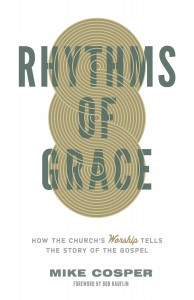Rhythms of Grace | Mike Cosper
Rhythms of Grace: How the Church’s Worship Tells the Story of the Gospel, by Mike Cosper (Wheaton: Crossway Books, 2013).
 Cosper, pastor of worship and arts at Sojourn Community Church in Louisville, Kentucky, roots his discussion of Christian liturgy in the Creation-Fall-Redemption-Consummation motif that he suggests summarizes the gospel and governs the storyline of Scripture. This biblical theme should inform Christian liturgy, Cosper argues, “because the gospel is all about worship” (26).
Cosper, pastor of worship and arts at Sojourn Community Church in Louisville, Kentucky, roots his discussion of Christian liturgy in the Creation-Fall-Redemption-Consummation motif that he suggests summarizes the gospel and governs the storyline of Scripture. This biblical theme should inform Christian liturgy, Cosper argues, “because the gospel is all about worship” (26).
Cosper explores this motif in the first four chapters of the book, contrasting in Chapter 5 what he believes to be a biblical model of worship with what worship looks like in most evangelical churches today, and he explains in Chapter 7 what he considers contributed to problems in contemporary worship. Chapter 6 reveals the influence of Smith’s Desiring the Kingdom in his argument that the goal of gathering in worship is to provide habits that will aid in spiritual formation. Likewise, Cosper’s summary of the shape of historical liturgy in Chapter 8 cites Chapell’s discussion. Chapters 9 and 10 break from the primary argument of the work thus far developed to address the matters of singing in worship and the worship leader’s responsibilities as pastor.
Although Cosper clearly builds off other work in his popular presentation, his discussion of the Creation-Fall-Redemption-Consummation biblical structure does contribute a metanarrative approach to the subject, and he offers an informative chart that moves beyond Chapell by illustrating how Chapell’s more specific liturgical shape fits in the larger structure (123).
Cosper’s description of what led to a neglect of a gospel-shaped liturgy is also very helpful, and because of the accessible nature of his writing, this portion in particular could provide a healthy corrective for churches today. He correctly identifies one of the primary roots of problems with evangelical worship with Revivalism, which he argues “transformed worship from the banquet hall to the concert hall” (111). He observes that most churches today use some form (intentionally or not) of the Wimber Temple/Tabernacle model of worship in which worship is essentially an experience of being “ushered into the presence of God.” Cosper argues that this is biblically and theologically inferior to the historic gospel-shaped liturgy that he is advocating (113).
The most puzzling part of Cosper’s work is the final two chapters. Rather than clearly fitting into the overarching argument of the book, it appears that Cosper simply appended these chapters because he felt the subjects needed to be discussed. The book would have been complete, and possibly even stronger, had he omitted these chapters. Chapter 10 is helpful on its own merits, but Cosper’s discussion of singing actually seems to contradict arguments earlier in the book. On the one hand, Cosper argues that worship creates habits that shape the believer either positively or negatively: “How we gather shapes who we are and what we believe, both explicitly (through the actual content of songs, prayers, and sermons) and implicitly (through the cultural ethos and personas)” (94). Yet in Chapter 9, even though he does acknowledge some weaknesses of contemporary songs today, he nevertheless continues to insist that musical form itself is neutral. This clearly contradicts his earlier discussion of how worship (even the “cultural ethos”) shapes us.
Nevertheless, Rhythms of Grace does provide an important and accessible explanation of why and how Christian liturgy should be shaped by the gospel. In some ways Cosper’s book may be even an improvement over Chapell’s since it explores more of the theological and biblical logic beneath a gospel-shaped liturgy rather than getting bogged down in discussions of historic practice.
